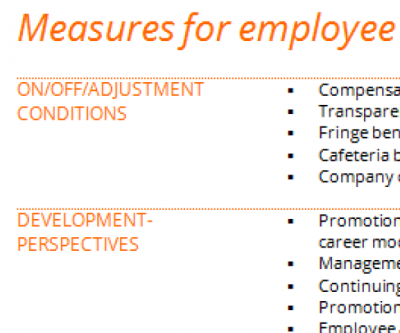
in Köln vom 10.09. bis 12.09.2024 in Halle 4.2 Stand F.12
A guide to your retention program
Make a profit
Strengthen employee retention: Reduce costs and maximize business success
Every company wants to retain its talents, high performers and specialists in the medium to long term. The successful retention of employees depends on numerous factors and general conditions. The range of factors that have a binding effect to ensure attractiveness as an employer is wide. Through excellent employee retention (also known as retention program or retention management), outstanding performance can not only be maintained, but also promoted and maximized for the company. Employees who identify with the company feel more responsible. Fluctuation is reduced, absenteeism due to illness is reduced and the quality of work results is higher. All this and many other effects of high employee loyalty increase success and minimize avoidable costs.
Employee loyalty is the normative, affective and emotional commitment of the individual employee to the company. Successful employer marketing and an increase in employer attractiveness are indispensable in order to retain personnel in the long term. The implementation of systematic employee retention measures is applied in retention management.
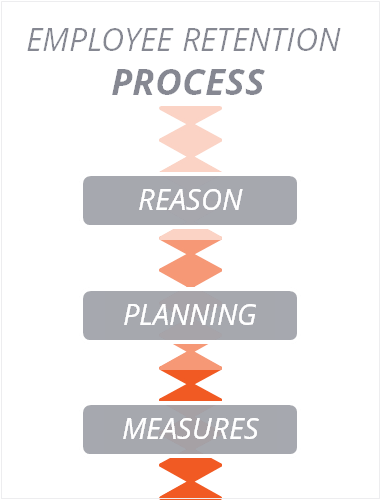
1 Reason for an employee retention program
1A Employee retention means being competitive
The reason to address the issue of employee retention arises, for example, from the feeling of a high fluctuation rate, a low level of employee motivation or an acute shortage of personnel.
In addition, companies are burdened in these times ... more
As a measure to improve the situation, an employee retention program can be the right tool of choice.
... more
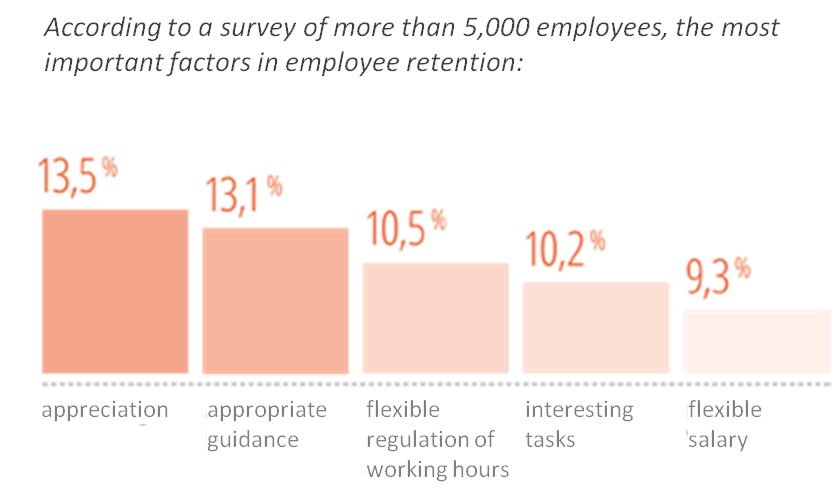
1B Analysis of employee retention status quo
The aim of the analysis of the status quo is to determine the positions and framework conditions of the organisation, the system and the employed individuals. Accordingly, the program should be geared towards improving employee retention.
Examples from studies on employee retention in German companies:
About 15% of German employees feel no or negative connection with their employer. About 13% feel a high emotional attachment to their employer.
About 62% of German employees feel a low or moderate attachment to the employer.
The damage caused by an inadequate employee attachment manifests itself on many entrepreneurial levels.
Main causes of poor employee attachment are incompetent leadership behavior.
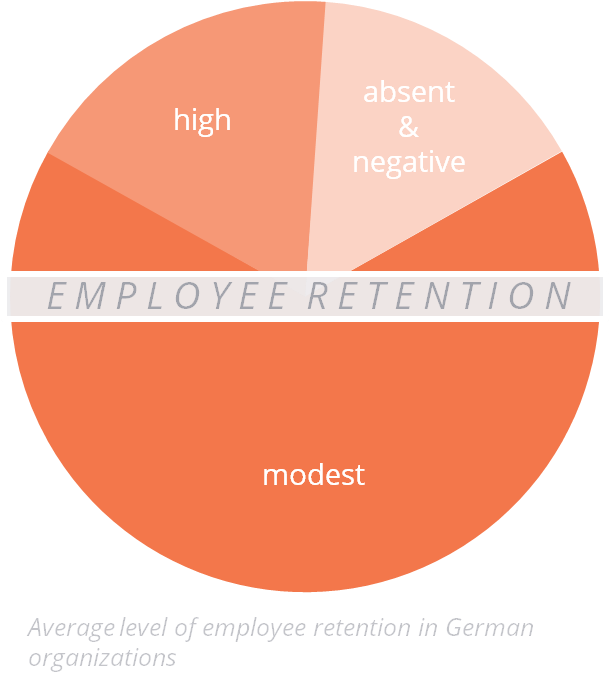
2 Planning an employee retention program
2A Employee retention on 4 levels - "Being connected to ..."
Corporate Loyalty. Today's understanding of corporate loyalty means less and less intensive, lifelong identification with the company. Neither the decision for the employer nor for the profession is unchangeable for employees. ... more
task commitment. In some industries, employees identify particularly with their profession - they feel "called" to do so. Examples of this are nursing professions, pastoral care or emergency services. The commitment to the company often plays a subordinate role. The degree of task commitment hardly predicts fluctuation intentions.
leadership commitment. Talents and top performers are attracted by successful organizations. The likelihood that the organization will be able to retain them depends largely on the quality of management. ... more
Team Retention. Research and development units play a special role in teambuilding. A high degree of development is achieved in teams of three to eight people. Team formation and team retention are factors that can strengthen the length of employment, company success and performance.
2B Construction of an employee retention program
Strategic planning of the employee retention program makes it possible to implement the measures in a targeted manner and to control their effects. Measures to increase employee loyalty should pursue three target factors:
Maintaining the potential of human resources
FLUCTUATIONSURSACHEN BÄÄMPEN
The decisive fluctuation factors for employees must first be identified in order to derive measures against it. It is advisable to carry out a survey after an employee has left to get an impression of the causes and reasons for leaving. If necessary, this information enables the employee to be bound by appropriate offers.
combination of the most frequently mentioned reasons for fluctuation:
.
- insufficient knowledge about own rights/obligations and tasks unsatisfactory task
- unsatisfactory task field
- professional information about company news
- lower recognition of achievements
- little decision-making power and opportunities to participate
- excess load
- bad superior relationship
- insufficient salary and career prospects
- bad working atmosphere
COST SAVING BY SINKING FLUCTUATION<
On the basis of an average German company with 1,000 employees, the costs per leaving are estimated at approximately 36,000 euros. The following sources can cause these costs:
- insufficient knowledge about own rights/obligations and tasks unsatisfactory task
- unsatisfactory task field
- professional information about company news
- lower recognition of achievements
- little decision-making power and opportunities to participate
STRONG EMPLOYEE SATISFACTION
Who is enthusiastic about his work and can identify with his company will not quit. The most effective approach to achieve this employee satisfaction is to meet the individual needs of the employee.
Increase the success of the company
COST SAVING BY STRONGER RELATION OF EMPLOYEES
Studies show that employees without or with negative company ties cause additional annual costs.
Examples for additional costs due to inadequate employee ties:
- Failures
- Thefts, damage caused
- negative effect on customers, applicants etc.
- disability of the service providers
- low working speed
- lacking implementation of receiving information
These costs can be avoided through positive employee retention. It is estimated that the savings through employee retention measures in an average German company of 1000 companies is 17,000 euros per employee per year.
PERFORMANCE
Numerous studies show: Higher employee retention leads to higher performance, especially emotional retention is effective. Employees who are loyal to their company usually voluntarily perform more than the duties arising from their employment contract.
INTERNAL CORPORATE COMMUNICATION
The orientation of corporate communication should focus on success and goals. This provides the opportunity to value and motivate employees. Success-oriented incentive systems with variable remuneration systems are highly effective.
LEGISLATIVE/MANAGEMENT
A good employee retention increases the individual performance of the employee and thus the success of the company.
Increasing employee retention through success-oriented leadership:
- Ensure framework conditions for the processes so that employees can develop their individual competencies
- corresponding targeted management of skills so that they lead to success
- open and clear communication of goals, successes and information Clear demarcation of tasks and responsibilities trustworthiness, authenticity, credibility
HR AS STRATEGIC BUSINESS PARTNER
The personnel management supports and accompanies the leadership, starting with personnel selection up to the definition of incentive systems. When HR department and executives cooperate, the benefits can be obtained through employee competencies.
Increase attractiveness as an employer
LEARNING FROM FAULTS
satisfaction of existing employees and especially high performers is the basis for good employee retention. True satisfaction means lasting employee loyalty. Even if the external image of the company is polished (e.g. through advertising campaigns) - false promises do not represent a long-term solution. Potential employees can obtain information through social media and rating portals (e.g. kununu). Dissatisfaction of current and former employees has a significant influence on the decision for or against a company. Large corporations such as Google can be useful role models. They specifically try to satisfy all private needs of their employees in order to achieve maximum loyalty to the company.
ALLEINSTELLUNGSMERKAMALE
To make an attractive impression on applicants as a company, it is helpful to take the applicant's point of view and to consider what needs this target group has. The most effective are emotional characteristics such as individual design of the work content and family-friendly working conditions.
TARGET GROUP
Target groups can be classified by beginners, experienced professionals and executives. It is also possible to divide according to characteristics:
- Occupation-related characteristics e.g. work experience, further trainingsociodemographic data: e.g. age groups, gender
- psychological data: e.g. goals, values
ZENTRALE BOTSCHAFT<
The employer communication should be directed only at the company-relevant target groups. It makes sense to disclose the lived company values and also to show corners and edges.
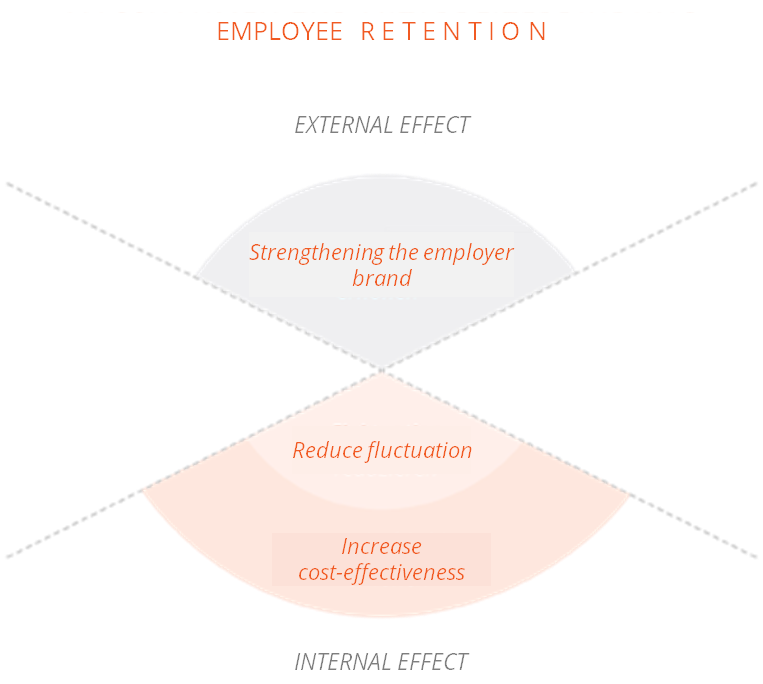
3 Action implementation for stronger employee retention
3A Employee retention measures and those responsible
There are various measures for increasing employee retention by area of responsibility. All the tips and measures are ultimately about finding out how work has to be designed so that it enriches life instead of getting in its way. The answer is employee retention. Examples of actions by area of responsibility:
Responsible: Human Resources / Human Resources Department
HR itself can primarily implement measures that increase employee retention among the general workforce. In addition, HR provides support when managers want to implement individual or specific measures. HR provides tools for this, trains the managers in the application, pays attention to the quality of the implementation and to the topicality of the tools. Examples for HR instrumentsto increase employee loyalty
- Working time models tools for measuring potential and performance personnel and position portfoliostarget agreement processes
- Talking Guide
Responsible: management staff
The managers of companies are a rather neglected factor in the past in terms of employee retention.
The majority of those surveyed are now aware of the role of the manager, but it is often difficult or impossible to implement the desired situation in reality. In addition to the personal suitability of the manager, the right leadership also depends on the measures employed. Leadership quality and employee retention can be improved and strengthened through relevant tools, instruments and measures. Leaders can personally strengthen employee loyalty through open, respectful and trustful behavior. In addition, measures should be implemented with the support of other bodies (e.g. IT department, internal communications department or HR).
Responsible: Management of the company
The management of a company is of course also in the role of a manager. The preceding contents thus also apply to the management. In addition, the management is decisive for the management culture at all levels in the company. The management also has the greatest overview of the processes of the departments. This enables them to assess which managers are already doing much and which are still doing too little to ensure strong employee loyalty. She knows the competencies of personnel management and can assess to what extent they can work autonomously or need additional impulses from outside. By working closely with those responsible for internal communication, management measures can be placed directly in the company.
3B Selective retention with main focus on top performers
The goal of selective employee retention is to identify and retain people who are relevant to success. So-called "top performers" make up approx. 20 % of the workforce and typically have the following roles:
- Performers (high and top performers)
- potential carriers (promising talents) Holders of positions of high strategic importance
- experts with expertise or skills that are rarely available on the market
Mid-performers", which make up around 60 % of the workforce, can also be developed into "top performers" with good personnel and management work. "In comparison, "low-performers" are resistant to measures for employee retention and boycotting, often even measures to improve employee satisfaction or retention. That is why the (main) focus of all measures for employee retention is on top and mid-performers.
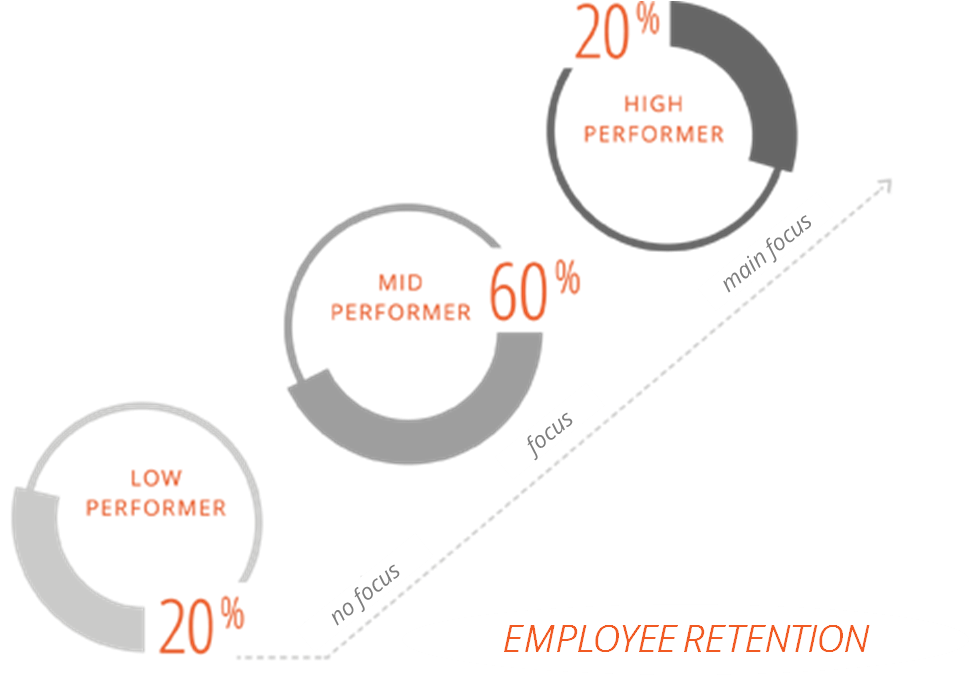
Interview with Prof. Ralf Lanwehr
3C Which measures for
employee retention work?
Which measures for employee retention do you know and which work best from your experience in practice?
Prof Ralf Lanwehr: The discussion is very long and in principle you can break it down to the question: Are there best practices or are there best cases? The question is clearly answered: there are hardly any best practices. In 2005, Pfeiffer examined 13 best practices to determine whether they function across industries. The answer is no.
In 2012, Jiang conducted a large meta-analysis in parallel: he examined how 61 measures contribute to the financial success of the company.
Show the whole answer>>
He has divided them into
- Opportunity-enhancing measures: these affect the environment of the employees,
- motivation-enhancing measures: these concern motivation and
- Ability-enhancing measures: these affect the properties.
Yes, there is a large influence of HR measures on the success of a company, this can be proven quantitatively, but no best practices are known.
Key statements on employee retention measures
- Focus on best cases instead of best practices
- Metaanalysis of Jiang - 61 measures => variance elucidation of 26 %, difference between good and bad companies High Performance Worksystems: Measures must be adapted to the company

3D Selection and evaluation of measures for employee retention
As described above, the goals of an employee retention program are defined according to the occasion from which the measures can be derived. The multitude of all possible measures can be evaluated as follows:
- preserving potential: How strong is the measure for increasing the retention time? How strongly does their absence affect the fluctuation rate?
- Corporate success: How strong is the measure for increasing performance? How strong is their lack of performance-inhibiting?
- Employer attractiveness: How strong is the measure for increasing employer attractiveness? How strong is their absence on the deterrence of applicants?

